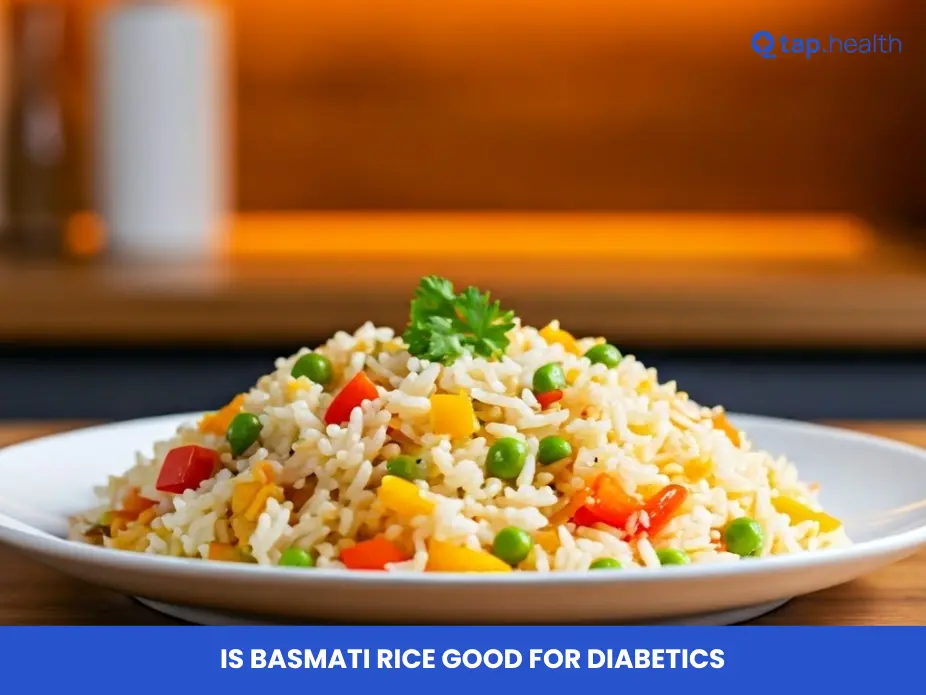For millions of Indians, a meal without rice feels incomplete. Whether it is Rajma Chawal in the North or Sambar Sadam in the South, rice is the soul of our kitchen. But the moment you are diagnosed with Type 2 Diabetes, the first advice you usually hear is: “Stop eating rice immediately.”
It is a heartbreaking moment. You wonder, “Do I really have to give up my favourite food forever?”
If you are searching for “Is Basmati Rice Good for Diabetics?”, you are looking for hope. You want to know if there is a middle ground.
As a senior health strategist, I have good news for you. The answer is not a simple “No.” It is a careful “Yes, but…”
In this guide, we will break down the science of Basmati rice using the KISS method (Keep It Simple, Stupid). We will look at why Basmati is special, how it affects your blood sugar, and the secret ways to cook it so you can enjoy it safely.
The Big Question: Why is Rice Considered the “Villain”?
To understand if Basmati is good, we first need to understand why rice has a bad reputation.
It all comes down to one word: Carbohydrates (Carbs).
When you eat rice, your digestive system breaks it down into sugar (glucose). This sugar enters your bloodstream, giving you energy. For a normal person, insulin helps move this sugar into cells. But for a diabetic, this process is broken. The sugar stays in the blood, causing a “spike.”
The “Traffic Light” of Rice (Glycemic Index)
Doctors use a scale called the Glycemic Index (GI) to measure how fast a food spikes your sugar. Think of it like a car speed.
- High GI (70+): A Ferrari. It spikes your sugar instantly. (Example: Sticky Jasmine rice, white bread).
- Medium GI (56-69): A family sedan. It raises sugar, but steadily.
- Low GI (55 or less): A bicycle. It raises sugar very slowly and safely.
Most short-grain Indian rice varieties (like Sona Masoori or Ponni) are often high GI. They digest fast and spike sugar fast. This is why doctors say “No.”
Why Basmati Rice is Different
Basmati is not like other rice. It is the “King of Rice” not just for its aroma, but for its chemical structure.
1. The Magic of Amylose
Basmati rice is rich in a specific type of starch called Amylose. Imagine two types of string:
- Amylopectin: A messy, tangled ball of wool. It is easy for your stomach to cut through. (Found in sticky rice).
- Amylose: A straight, tight rope. It is hard for your stomach to cut. (Found in Basmati).
Because Basmati has high Amylose, your body takes a long time to digest it. This means the sugar is released slowly into your blood, not all at once.
2. The GI Score of Basmati
According to the Diabetes Foundation (UK) and varying studies:
- Traditional White Basmati Rice has a GI between 50 and 58. This places it in the Low to Medium GI category.
- Compare this to standard short-grain white rice, which can have a GI of 70+.
Verdict: Basmati is significantly better for your blood sugar than standard sticky rice.
White Basmati vs. Brown Basmati: The Showdown
You will often hear, “Just eat Brown Rice.” But let’s be honest, Brown Rice takes longer to chew and has a different taste. Is it really necessary?
White Basmati Rice
- What is it? The bran (outer coat) is removed.
- Pros: Tasty, cooks fast, easier to digest.
- Cons: Less fibre.
- For Diabetics: Acceptable in moderation (Low-Medium GI).
Brown Basmati Rice
- What is it? The whole grain with the bran layer intact.
- Pros: Packed with Fibre. Fibre acts like a net in your stomach, trapping sugar and slowing down absorption even more.
- Cons: Chewier texture, takes longer to cook.
- For Diabetics: The Best Choice. The fibre ensures an even lower blood sugar response.
Key Takeaway: If you can tolerate the taste, Brown Basmati is superior. However, White Basmati is still a safe option if you practice portion control.
Real-Life Scenario
Let’s see how this works in a real Indian home.
The Scenario: Mr. Sharma, a 55-year-old retired banker from Delhi, was diagnosed with Type 2 Diabetes. He loved his Sunday Biryani. His doctor told him to stop rice completely. For two months, Mr. Sharma ate only Roti. He felt miserable, unsatisfied, and actually started overeating Rotis because he missed rice. His sugar levels didn’t improve much because 4 Rotis contain a lot of carbs too!
The Shift: We introduced Basmati Rice back into his diet, but with three rules:
- Portion: Only one small katori (bowl) of cooked rice.
- Pairing: He had to eat it with a large bowl of Dal and a plate of salad (Cucumber/Tomato).
- The Swap: He switched from sticky white rice to long-grain Basmati.
The Result: Mr. Sharma felt mentally happier. Because he was eating protein (Dal) and fibre (Salad) before the rice, his sugar spike was cushioned. His HbA1c levels stabilized, and he no longer felt deprived.
Expert Contribution
Based on consensus from certified diabetes educators and nutritionists.
Dr. S. Iyer, a Clinical Nutritionist specialising in Diabetes management, explains:
“The problem isn’t the rice; it is the quantity and the method. In India, we treat rice as the main dish and vegetables as the side dish. For a diabetic, we must flip this.
The Plate Method: Imagine your plate is a clock.
- 12 to 6 (Half the plate): Should be Green Vegetables (Palak, Beans, Gourd) or Salad.
- 6 to 9 (Quarter plate): Protein (Dal, Chicken, Fish, Paneer).
- 9 to 12 (Quarter plate): Carbohydrates (Basmati Rice).
If you follow this ratio, Basmati rice is absolutely safe. The fibre and protein from the other foods will slow down the digestion of the rice.”
Recommendations Grounded in Proven Research and Facts
If you want to include Basmati rice in your diet safely, you must follow these evidence-based recommendations.
1. The “Cooling Hack” (Retrogadation)
The Science: A study published in the Asia Pacific Journal of Clinical Nutrition found that cooling rice changes its structure. The Trick: Cook your Basmati rice. Let it cool down in the fridge for 12 hours. Reheat it before eating. Why: This process turns the starch into Resistant Starch. Your body cannot digest resistant starch easily, so it passes through without spiking your sugar. It acts like fibre!
2. The “Drain” Method (Removing Starch)
The Science: Pressure cookers trap the starch in the rice. The Trick: Cook rice in an open pot with lots of water (like boiling pasta). Once cooked, drain the white, starchy water completely. Why: This removes a significant amount of the free starch that causes sugar spikes.
3. Portion Control is Non-Negotiable
The Fact: Even Brown Basmati will spike your sugar if you eat a mountain of it. Recommendation: Limit your intake to 1 cup of cooked rice (approx. 150g) per meal.
4. Add a “Speed Breaker” (Fibre & Fat)
The Fact: Eating carbs alone causes the fastest spike. Recommendation: Add a teaspoon of Ghee to your rice. The healthy fat slows down digestion. Never eat plain rice; always mix it with high-fibre vegetables or beans (Rajma/Chole).
Frequently Asked Questions (FAQs) on Is Basmati Rice Good for Diabetics?
Can I eat Basmati rice every day if I have diabetes?
It depends on your current blood sugar levels (HbA1c). If your levels are well-controlled, you can eat a small portion (one katori) once a day, preferably at lunch when your metabolism is higher. Avoid eating rice at dinner 2 hours before sleeping.
Is “Diabetic Rice” sold in markets real or a scam?
Some brands sell “Low GI Rice.” These are usually parboiled varieties where the husk nutrients are pushed into the grain during processing. They are genuinely better than standard white rice, but Basmati naturally has a similar or better GI profile. You don’t necessarily need to pay extra for “Diabetic Rice” if you buy high-quality, aged Basmati.
Can I eat Biryani?
Biryani is tricky. While it uses Basmati, it is also heavy in oil and often has potatoes. The high fat can delay the sugar spike, but it can lead to a sustained high sugar level hours later (the “pizza effect”). Tip: Eat a smaller portion of Biryani and fill up on Raita (make sure the Raita has no sugar) and salad.
Does soaking rice help?
Yes! Soaking Basmati rice for 30 minutes before cooking allows the grains to expand and cook better. More importantly, washing the rice 3-4 times until the water runs clear removes the surface starch, which slightly lowers the glycemic load.
Which brand of Basmati is best?
Look for “Extra Long Grain” or “Aged” Basmati. Aged rice (1-2 years old) is drier and fluffier. Newer, cheaper rice tends to be stickier and starchier, which is worse for diabetes.
Conclusion: The Final Verdict
So, is Basmati rice good for diabetics?
Yes. It is one of the best rice options available for managing blood sugar, thanks to its low-to-medium Glycemic Index and unique starch structure.
However, Basmati is not a magic pill. It is still a carbohydrate.
- Eat it: In small portions.
- Cook it: By draining the water.
- Pair it: With lots of vegetables and protein.
You do not have to divorce your love for rice. You just need to change the relationship to one of moderation and respect.
References
Mayo Clinic: Diabetes Diet: Create Your Healthy-Eating Plan – Link to Mayo Clinic
Harvard Health Publishing: Glycemic Index for 60+ Foods – Link to Harvard Health
Diabetes UK: Rice and Diabetes: What You Need to Know – Link to Diabetes UK
National Institutes of Health (NIH): Effect of cooling of cooked white rice on resistant starch content and glycemic response – Link to NIH Study


